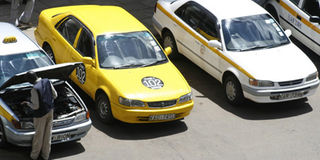How to run a side-hustle taxi business (Part I)

Taxis at a car park in Nairobi. PHOTO| FILE| NATION MEDIA GROUP
What you need to know:
- You’d imagine that the informal jungle of the taxi business was no place for a seemingly snobbish girl like me.
- It was a place for me because I was bringing something to the table; they needed the extra cars, I needed the extra money.
Groundwork also helped me sleep better at night knowing I’d made an informed decision to invest my money in these taxis.
Throw a stone in this town and it’s likely to land on someone who runs a taxi with Uber.
I ran my taxi business before these apps pulled the rugs from under our urban feet. I ran it for three years – from September 2012 to September 2015. I had three taxis on the road at its prime.
These apps changed how we consumers engage with taxis. They also changed how to manage a taxi business, and account for its expenditure and returns.
The app logs all activity and, in essence, is a barometer for the driver’s personal integrity. It’s also a car tracking device right there on your phone. In your hands.
Back then, the tracking devices we installed for our taxis cost about a pint of blood and involved frequent unexciting logins into the software.
What follows is a roadmap to how I set up and run my taxi business. I’ll throw in figures that’ll likely make the story difficult to digest, stay with me.
MONTHS OF RESEARCH
You’d imagine that the informal jungle of the taxi business was no place for a seemingly snobbish girl like me. But it was. And it is for anyone, actually.
It was a place for me because I was bringing something to the table; they needed the extra cars, I needed the extra money. Everyone goes home happy.
Research had also shown me how the fleet managers managed the taxis day to day – how much they paid drivers and taxi owners, how frequently they fuelled and serviced the cars, how much these and such other operating expenses cost, what they wanted in a business partner like me.
Groundwork also helped me sleep better at night knowing I’d made an informed decision to invest my money in these taxis.
GETTING STARTED
A taxi business is the quintessential capital-intensive business – you need lots of cash to finance your idea off the ground. For instance, a 2012 Toyota Belta is averaging for Sh950,000 (I've just looked that up on Cheki, the online marketplace for cars).
Think of this as the cash you need, at minimum, to start a taxi business.
Unless you’re in the black market trading organs or are laundering dirty money, I don’t know if you’d have such cash lying around. I didn’t. I applied for a loan from Standard Chartered Bank.
The collateral for the loan was my payslip. (I was a corporate suit back then; my payslip could wow any financier. Now my payslip doesn’t wow anyone. Ha-ha. Not even me.)
The other option would have been to apply for a Sacco loan. Sacco loans are cheaper than bank loans.
Anyway. I purchased two Toyotas – a Fielder and an NZE. I got the Fielder from a dealer in the Coast, the NZE from some lady here in Nairobi, she was upgrading to new car (I’d later learn that this purchase was not a smart one).
Aside from the purchase cost of the cars themselves, there was also the cost of PSV insurance, KRA inspection certificates, agents’ fees, transferring logbooks to my name, initial repairs and service to the cars, and other miscellaneous costs that kept creeping out of the woodwork.
The loan I took from the bank was for Sh1.5 million. It’d run for five years. I’d be charged a monthly interest rate of 19.9%. I was repaying per month Sh50,715.
I had another small loan running with my Sacco at the time of taking this bank loan. The bank told me they’d buy off the loan balance from the Sacco, so I was left financing this one huge loan from them. I don’t know why but I felt good about this.
Also, the monthly repayments I’d been making on this small Sacco loan was an indirect income from my taxi business.
THE RETURNS
I'd get from each taxi per month, a flat rate of Sh30,000. That’s a total of Sh60,000.
I’d also make a saving on the small Sacco loan I’d been servicing, the one the bank bought off and incorporated into their one-huge loan. I was repaying to this small loan, per month, Sh15,500. So that’s a total of Sh75,500.
Taking into account what I’d invested and what I’d get as returns monthly, I’d make my money back in about 20 months. I’d also still have the cars themselves, they’d be depreciated but they’d be worth something in the market. Toyotas have great resale value.
In a nutshell, I’d have monthly income plus assets with value to my name.
HOW I'D GET PAID
The fleet managers would deposit the cash to my bank account on the 30th of every month.
***
This story continues next week. I’ll tell you about the risks of running the business, how I managed these risks and went on to manage the business itself. I'll also tell you what happened in the 36 months of running it, and how the curtains closed on it.
You really want to hang around for that one.




